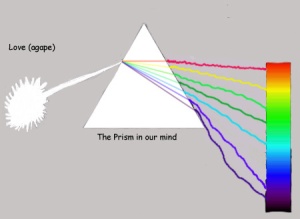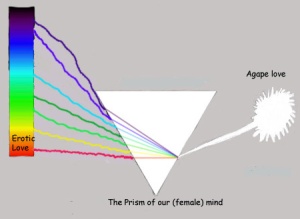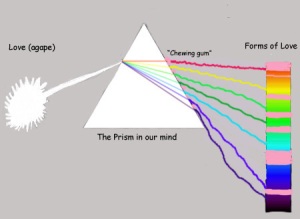Erotic love is as essential as groceries and most of us are starving to death… or eating at McDonalds. Love is currently defined as a feeling, generated by altered brain chemistry and then, generally between a man and woman. This definition of love limits our capacity as human beings. The proposed model of love is simply a model from which many simplistic observations can be made.
The Greeks had a word or six for love, but the Cologne Sanskrit Digital Lexicon lists 531 responses to a search for the word love. In English, we have only one: love. The most generic word in Greek is Agape, and in Sanskrit is anaGga, which we would think of as “unconditional love.” It is from these generic words the other “forms” of love flow. This article suggests these “forms” are but segments of a spectrum. Whereas most articles and books on love are limited to erotic love and the associated brain chemistry as an internal mechanism, this proposes love is both internal and external as well as being much larger than erotic love. The attraction of erotic love is possibly due to the passionate energy developed during the process, being much greater than gazing upon a sunset, or any other love.
The two-dimensional, Newtonian model is based on the visible light spectrum (VLS) with white light representing unconditional love, our minds as the prism, and the various colors as the “forms” of love.
Fig. 1. Love as a Metaphorical Spectrum
Associating the colors with specific forms, led only to two: red and orange for erotic love and violet for a “spiritual” love. This is in keeping with Eastern “chakras” in the human body. In that light, to ask a Zen master how the other forms fit in the spectrum would only yield another question: “What difference does it make?” What is interesting is to note, is the association of The different “forms” of love, or absences of love, or segments of the spectrum, with ancient gods and goddesses.
For example, the Greek God Eros was originally thought of as the son of Aphrodite and Ares. He is a primeval deity who embodies not only the force of erotic love but also the creative urge of ever-flowing nature, the firstborn Light for the coming into being and ordering of all things in the cosmos. Plato changed all that in his symposium.
Aphrodite, was the Greek goddess of love, pleasure and beauty. We have two deities for erotic love. Note the prism is in the shape of the blade, the male symbol. Inverting it to the chalice yields the same spectrum, but in reverse order, giving us wonder as to whether or not women perceive love differently?
Fig 2. Female Prism?
This model of light energy presumes then that love is energy. At this time, it would be perceived as an “etheric” energy because we know as much about this energy as we knew about electricity 300 years ago. Yet, love has both attributes of energy: transmittal and transformation. We can transmit love with a smile. The smile makes us feel better and perhaps the person we are smiling to feels better also. We have “transformed” our feelings. Expanding on this in the field of Consciousness, what is considered an increase in consciousness is also referred to as “transformation,” or “transmutation,” or “awakening,” etc. So, we can look at love as energy. This is not to say love is or is not energy. It is simply a way of looking at it.
For a moment, assume it is energy. Energy has freequency and amplitude. Erotic love is then most powerful because of the amplitude (passion) associated with it. Of course the term “transmutation” implies genetics and the recent science of epigenetics. Another question arises from considering love as energy: could this energy create “chemical signals” to tweak, or restructure genes, thereby altering our brain chemistry, promoting an “increase in consciusness?” Similarly, could love be the energy altering our brain chemistry to generate the “feelings” of love? Mother love is certainly a different feeling than erotic love yet can be as powerful in its own way.
Behaviors of Love
The accepted behaviors of love are: communication, nourishing, touching, grooming, gazing and play. These behaviors fall across the spectrum with the diffenence being in the intimacy between the giver and receiver of love. We can nudge or give a pat on the back to a comrade with whom we have developed a friendly relationship (Philos, Brotherly love) of either gender. However, until we have developed a level of erotic intimacy with an individual, erotic touching or any of the other erotic behaviors, violates boundaries. Violating boundaries is not a behavior of love.
Shortfalls of the Spectrum Model
1. Obviously it is two-dimensional and Newtonian. However, Newton noted when a specific area of the prism was blocked, that color did not appear. This model allows us to view our blockages to love as though someone had placed “chewing gum” on the prism. These can also be viewed as memes, erroneous beliefs or inculturated behaviors.
Fig. 3. Love’s Prism with Chewing Gum
2. Metaphorically, using the sun as a primary source of light, we know that light energy (photons) is not the only energy put out by the sun: beta and gamma rays, radio waves and a host of other things are emitted by the sun. Therefore, the VLS model is only the beginning of what may be found in the love spectrum. Further, mauve is certainly a color not included in the spectrum of primary colors.
3. Two dimensionality. This model is only to suggest another, more expansive way of looking at love. It is quite possible the linear segments we can visualize are only a part of another, non-linear geometry
Conclusions
1. Love may be viewed as an energy spectrum.
2. Love may exist both internally and externally.
3. Most other views of love are limited to a specific “form.”
Copyright 2013 Art Noble


